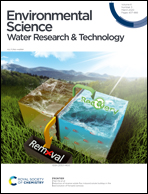Thin film nanocomposite nanofiltration membrane incorporated with cellulose nanocrystals with superior anti-organic fouling affinity
Abstract
Thin film nanocomposite (TFN) nanofiltration (NF) membranes were fabricated by incorporating cellulose nanocrystals (CNCs) in a polyamide (PA) layer. The membranes were synthesized by in situ interfacial polymerization of piperazine (PIP) and trimesoyl chloride (TMC) containing different amounts (0.0, 0.01, 0.05, and 0.1 wt%) of CNCs. Successful incorporation of CNCs into the polyamide layer was confirmed by ATR-FTIR analyses. The morphology of the membranes was investigated using SEM. Water contact angle measurements showed improved hydrophilicity of the TFN membranes. The nanofiltration performance of the membranes for saline solutions (Na2SO4, NaCl, MgCl2, and CaCl2) at a concentration of 1 g L−1, pressures of 6, 8 and 10 bar, a temperature of 25 °C and a constant feed solution flow rate of 2.25 L min−1 was investigated. Increases in CNC loading in the PA layer and the operating pressure lead to significant increases in water flux. By increasing the CNC loading to 0.05 wt% in the PA layer, the Na2SO4 rejection increased at all pressures. The increment of CNC concentration to 0.1 wt% resulted in reduction of Na2SO4 rejection due to defect formation in the PA layer. The TFN membrane fabricated using 0.05 wt% CNCs (TFN 0.05) showed a water flux of 22.47 L m−2 h−1 and a Na2SO4 rejection of 93.44%. The trend of salt rejection for the TFN 0.05 membrane is as follows: Na2SO4 (93.44%) > MgCl2 (79.52%) > CaCl2 (71.03%) > NaCl (62.68%). The TFN 0.05 membrane could significantly improve bovine serum albumin (BSA) fouling compared to the TFC membrane during the NF process. In addition, about 22.5% of the water flux of TFN 0.05 could be recovered by a simple water rinse, which indicates that organic fouling in NF0.05 is highly recoverable.



 Please wait while we load your content...
Please wait while we load your content...